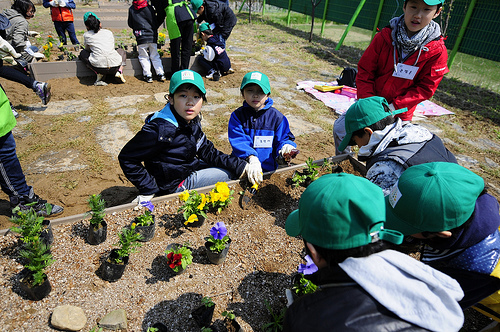
Junior Master Growers-Korea plant flowers in the People’s Garden at the Gwacheon National Science Museum.
You may remember when USDA Secretary Tom Vilsack announced last June that People’s Garden’s existed in all 50 states, two U.S. territories, and three foreign countries. Since then, People’s Gardens are cropping up at Foreign Agricultural Service (FAS) posts throughout the world. Read more »
More than 112,000 Rio Grande Valley moms, infants and children depend on the nutritional benefits provided by WIC – the Special Supplemental Nutrition Program Women, Infants and Children. The four counties that make up the Valley (Cameron, Hidalgo, Starr and Willacy) have done a good job of identifying and serving nutritionally at-risk households using innovative outreach methods. They have caught the attention of USDA Director of Faith-Based and Neighborhood Partnerships Max Finberg and USDA FNS Southwest Regional Administrator Bill Ludwig, who toured Hidalgo County’s main WIC clinic on April 11. Read more »
A new report titled Measuring Up: Synchronizing Biodiversity Measurement Systems for Markets and Other Incentive Programs was just released by the Willamette Partnership with funding and support from USDA’s Office of Environmental Markets (OEM). The report analyzes 25 existing biodiversity measurement systems to identify the elements necessary for a good system. It presents a standard process for developing measurement systems and offers options for improving the performance of biodiversity markets and conservation programs. The report’s findings are useful to those interested in measuring conservation effects and increasing the effectiveness of incentive programs. For example, the report examines how to balance precision and usability, and standardization and customization. Read more »
In 2009, 14.7% of U.S. households were insecure, meaning that at some point during the year these households were uncertain of having, or unable to obtain, enough food. In addition to tracking and reporting on hunger in the United States, USDA plays a significant role in helping families acquire food through a myriad of nutrition programs (15 in all), inluding the Supplemental Nutrition Assistance Program and the National School Lunch Program.
An area of USDA support for finding solutions to hunger that may be overlooked is through our National Instutite for Food and Agriculture (NIFA), an agency within the Department that supports research, education and extension programs in the Land-Grant University System and other partner organizations. Last week we annouced eight awards totaling more than $18 million, made through the Agriculture Food and Research Initiative (AFRI), that are supporting local and regional food systems while investigating sustainable solutions to food access within those regions. Here’s a list of the projects: Read more »
Recently, a USDA Rural Development project received one of the 2011 Governor’s Awards for Historic Preservation from the Michigan State Historic Preservation Office. The ceremony was held in the state Capitol rotunda and dozens of citizens and legislators from across the state turned out.
Michigan State Housing Development Authority Executive Director Gary Heidel opened the ceremony by noting the rich historic heritage of Michigan’s towns and cities and how the preservation of these sites is vital to keeping our state a place where people work, live and spend their leisure time. Read more »
This post is part of the Science Tuesday feature series on the USDA blog. Check back each week as we showcase stories and news from the USDA’s rich science and research portfolio.
U. S. Forest Service social scientist Lee Cerveny has carved out a special niche in the world of research. While her colleagues go into national forests and other protected areas to study things like trees and wildlife, she enters these natural environments to study humans – how they interact with and use a range of sites and resources.
Read more »

